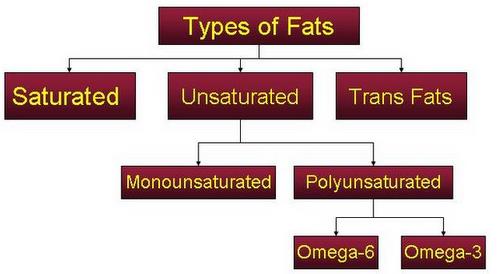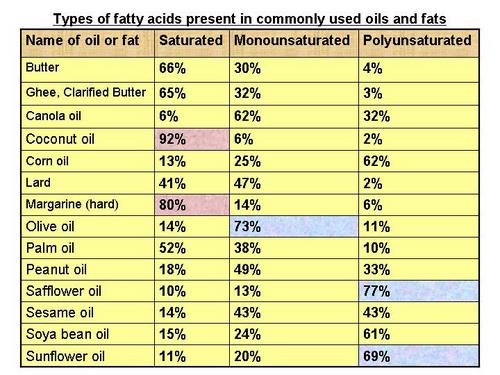|
Facts about fats and oils in your diet - learn about the types of fats used in cooking and their effect on healthUnderstanding your dietary fats and oils is very essential. Are all fats bad? How much fat should you eat? What are essential fatty acids? How to choose the best cooking oil? Before answering all these questions, let us know the importance of fats in our diet. So, Why do you need fats in your diet? Fats and oils supply essential fatty acids for a healthy skin and regulating body functions. Fat is part of every cell membrane in the body. It helps to transport nutrients and metabolites across cell membranes. Your body uses fat to make a variety of other building blocks needed for everything from hormones to immune function. Fats contain fat-soluble vitamins A, D, E and K, which are essential for your body. We all use fat for cooking as fats and oils make the food tasty, they give a smooth and creamy texture to food and contain compounds that impart flavor and smell. Your body needs fat What happens when we don't have enough fat in our diet? Dry, scaly skin, hair loss, low body weight, cold intolerance, poor growth in children, lower resistance to infection, to name a few. What happens if we consume too much of fats? Too much fats will lead to obesity and will result in major diseases like coronary heart problem, diabetes, arthritis, blood pressure and stroke, to name a few. The total intake of fats and oils, should comprise of not more than 30% of the total food intake in a day. Even that 30% should constitute of good fats (monounsaturated and polyunsaturated), rather than saturated and trans fats. It is very essential to choose the type of fat you eat, wisely.
Fats or Essential Fatty AcidsFats are made up of fatty acids. The essential fatty acids can be broken down into two main categories. Namely, saturated and unsaturated fatty acids. There are two kinds of unsaturated fatty acids - monounsaturated fatty acids and polyunsaturated fatty acids. The latter can be further divided into omega-6 and omega-3. Then there are trans fats. This flow chart will give you a broad gist of types of fatty acids.
So let us make an effort to know a little bit about all these fatty acids or fats and oils, where are they derived from, which ones are good, which ones are bad and why. Saturated FatsWhat are saturated fats? What foods provide saturated fats? Are saturated fats good or bad and why? Saturated fats are fats rich in saturated fatty acids. They tend to be solid at room temperature. In terms of fat chemistry, all fatty acids are made up of carbon (C), Hydrogen (H) and Oxygen (O2). So a fat is said to be saturated when it's molecules hold maximum amount of hydrogen. Foods that contain saturated fats The majority come from animal sources, including meat and dairy products. Examples are fatty beef, lamb, pork, poultry with skin, lard and cream, butter, cheese and other dairy products made from whole milk. Palm oil and coconut oil are also high in saturated fats. How does saturated fats affect the health? Eating foods that contain saturated fats raises the level of cholesterol in your blood. High levels of blood cholesterol increase your risk of heart disease and stroke. Be aware, too, that many foods high in saturated fats are also high in cholesterol – which raises your blood cholesterol even higher. So, how much of saturated fats can I have in a day? It is better to keep the consumption of saturated fats to less than 7% of your total calories. For example if you need 2000 calories a day, only 140 of them should come from saturated fats. Hence, it is a good idea to replace foods high in saturated fats with foods high in unsaturated fats like monounsaturated and/or polyunsaturated fats.
Monounsaturated fatsWhat is monounsaturated fat? Are they good or bad? Where are they derived from? How do they affect your health? Monounsaturated fat are liquid at room temperature. Chemically, their molecule holds less amount of hydrogen as compared to saturated fats. They are considered to be probably the healthiest type of general fat. Sources of monounsaturated fat The principal sources are olive oil, rapeseed oil, and foods such as avocados, nuts (such as almonds, hazelnuts, brazil nuts, cashew nuts) and seeds such as sesame seeds and pumpkin seeds.
Monounsaturated oils are good for cooking. Refined olive oil, especially is considered the best for cooking as it has a high oxidation threshold i.e. it remains stable at higher temperatures and does not easily become hydrogenated or saturated. Although, extra virgin olive oil has a low smoke point and should not be heated beyond 180°C. The high consumption of olive oil in Mediterranean countries is considered to be one of the reasons why these countries have lower levels of heart disease. Health benefits of monounsaturated fat Monounsaturated fat is believed to lower cholesterol and may help in reducing heart disease. It provides essential fatty acids for healthy skin and the development of body cells. It is also believed to offer protection against certain cancers (like breast cancer and colon cancer). Monounsaturated fats are typically high in Vitamin E, the anti-oxidant vitamin which is required by the body.
Polyunsaturated fatsWhat are polyunsaturated fats? Are they good fat or bad fat? And why? Polyunsaturated fats are typically liquid at room temperature and when chilled. Unlike the saturated fats and the monounsaturated fats, which the body can make it's own from carbohydrates and proteins, polyunsaturated fats cannot be produced by the body and therefore they need to be supplied by foods that contain them. Polyunsaturated fats – like all fats – contain nine calories per gram. All fats are equally high in calories. Health benefits of polyunsaturated fats The two main families of polyunsaturated fats are Omega-6 fatty acids and Omega-3 fatty acids. Omega-6 Fatty acids are needed by our body cells as part of the make-up and to produce a hormone like substance called 'eicosanoids', which helps to control a wide range of functions including blood flow and inflammation. Primary sources Caution - Very high intakes of omega-6 are bad as it produces free radicals. Omega-3 fatty acids are needed by the body as structural components of the brain and retina of the eye, during early development. They reduce inflammation and tendency of blood to clot. They may be helpful in treatment of heart disease and arthritis. Primary sources Trans fatsWhat are Trans fats? why are trans fats harmful? Trans fats are also known as hydrogenated fats. They are made by adding hydrogen to liquid vegetable oil under pressure. This results in a stiffer fat, a fat which is hard at room temperature. For example, vanaspati or hard margarine. They are industrially hardened and mostly used in commercially prepared foods to preserve the flavor and increase the shelf life of these foods. All the trans fats are essentially artificial, although there are some 'trans fats' found naturally in foods of animal origin (beef, mutton and dairy products).
Harmful effects of trans fats on health They harm by increasing the cholesterol levels in the blood. They also increase other harmful fats in the blood. They reduce the HDL (high density lipoproteins), also know as the "good cholesterol" and increase the LDL (low density lipoproteins), also know as the "bad cholesterol". That means trans fats cause double harm by raising the harmful lipids and bringing down the good lipids. They block the arteries and prevent blood from flowing through them. Trans fats are also very harmful to the children. It has been shown that children as young as 8 years, have high cholesterol and early stages of clogged arteries. Foods you should avoid in order to avoid consumption of trans fats Biscuits, breads, confectioneries, fried food items (crisps and namkeens), fried sweets, many cakes, pies and pastries, ready to eat meals, fast foods, junk foods, microwave meals and snacks and much of the street, restaurant and hotel food.
How to choose a good cooking oilWhich the best cooking oil? What is good for cooking - butter or oil? Based on the effects of saturated, unsaturated and trans fats on the body, it will be safe to say that cooking in oil is definitely better than cooking in butter. The cooking oil should have higher amount of monounsaturated and polyunsaturated fats and with minimal or no saturated fats and trans fats. Having said that, there is no difference between monounsaturated, polyunsaturated fat and saturated fat, in terms of calorific value. All fats and oils are high in calories. Hence, even oils classified as healthy, should be used sparingly. Let's have a look at the table below, containing commonly used fats and oils.
By looking at this table we can categorize some fats and oils as good and some as bad. Good Cooking fats and oils *Olive oil Bad Cooking fats and oils *Vegetable shortening (vanaspati ghee)
Ways to cut down on bad fats and oils intake to improve your healthRemember to use fats and oils sparingly. Try and substitute the saturated fats for the unsaturated ones. Make changes to your fat intake today, to enjoy a good healthy tomorrow. Here are some preventive measures you can take to avoid consumption of saturated fats and trans fats. * Use cooking styles that add little or no fat to food. Grilling, steaming, stewing is better than frying. * Go easy on the bakery products. Read the food labels. * Try spreading a thin layer of butter on toast, instead of a thick layer. * Use vegetable oils, instead of butter or lard or dalda for cooking. * In using cooking oils, choose olive oil and sunflower oil for cooking. * Avoid Coconut oil and palm oil, as they are high in saturated fat, even though they are vegetable oils. * Try to eat nuts and oily fish, instead of other meats, at least three days a week. * When consuming lamb, beef and pork, go for lean cuts. * Eat the chicken without the skin. * Substitute whole milk for skimmed milk or even soya milk. * Use reduced-fat or no-fat salad dressings with salads, for dips or as a marinade. * Try to replace some of the meat you eat with beans or legumes. * Try to cook simple, healthy food at home and eat out only occasionally. Top
of fats and oils
|
creative-cooking-corner.com

















